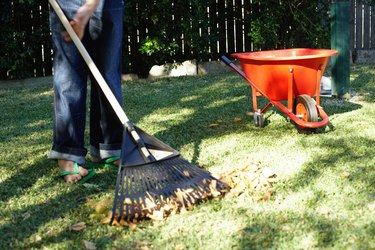
After a busy summer of family activities or travel, the lawn may have been neglected and eventually becomes too weedy, sickly or displays bare patches. Rather than installing an entirely new lawn with expensive sod, you can opt to seed the bare or thin areas of the lawn in an effort to reestablish grass. In the Pacific Northwest, cool-season grasses, such as ryegrass, fescue and bluegrass, dominate lawns. Depending on your location, fall or spring reseeding of the lawn is best.
Best Time Frame
Video of the Day
The best time to reseed a cool-season lawn is when growing conditions are conducive to seed germination and quick but thorough establishment of seedlings. Cool-season grasses prosper when air temperatures are between 60 and 85 degrees Fahrenheit and the soil remains evenly moist and 50 to 65 F. Depending on latitude and elevation in the Pacific Northwest, these conditions occur either in mid-August through early October or mid-April to late May. Avoid planting seed during the heat of summer or in late fall, when freezes kill sprouting grass seeds.
Video of the Day
Regional Insight
In Oregon, the best time to reseed a lawn is from mid-August to mid-September. In the higher elevations in the western counties, earlier sowing in August may be preferred compared to reseeding later in September. If you miss the late-summer time frame, the next best time is early May to mid-June. In Washington, April and May are considered the best time to sow cool-season grasses, according to the Washington State University Extension Service. The second-best time is August and September. In western Washington, where winters are milder, reseeding can occur as late as mid-October with satisfactory results.
Recommendations
Variations in elevation, winter temperatures and seasonal rainfall across the Pacific Northwest, mainly from west to east, make a general lawn-seeding time frame more difficult. In higher elevations with colder winters and less rainfall farther inland, spring seeding may be best to ensure the grasses are not damaged by cold or dry soils. Contact your county cooperative extension office to learn of reseeding recommendations specific to your area's climate and soils.
Site Preparation
Prior to scattering seed, remove fallen tree debris and as many weeds as possible from the lawn. Perennial weeds are especially problematic, as they sprout back from roots if the plants are broken off rather than completely pulled up. Scratch the soil with a rake to a depth of 1 inch and grade the planting areas smooth. Scatter seed in two perpendicular directions for good coverage and scratch the seed into the soil to a depth of 1/4 inch. Roll the area to bring the seeds in direct contact with soil. Gently irrigate the area and keep the soil evenly moist. To conserve moisture and reduce soil temperatures, a light topping of weed seed-free straw may be scattered thinly atop the seeded areas.